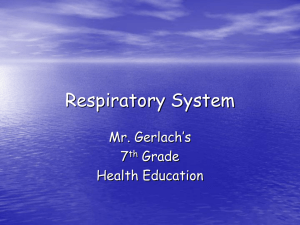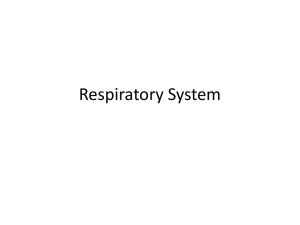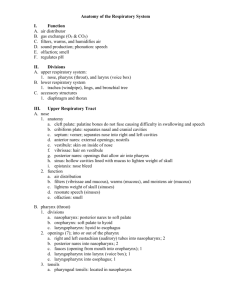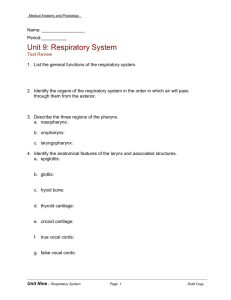Clues
advertisement
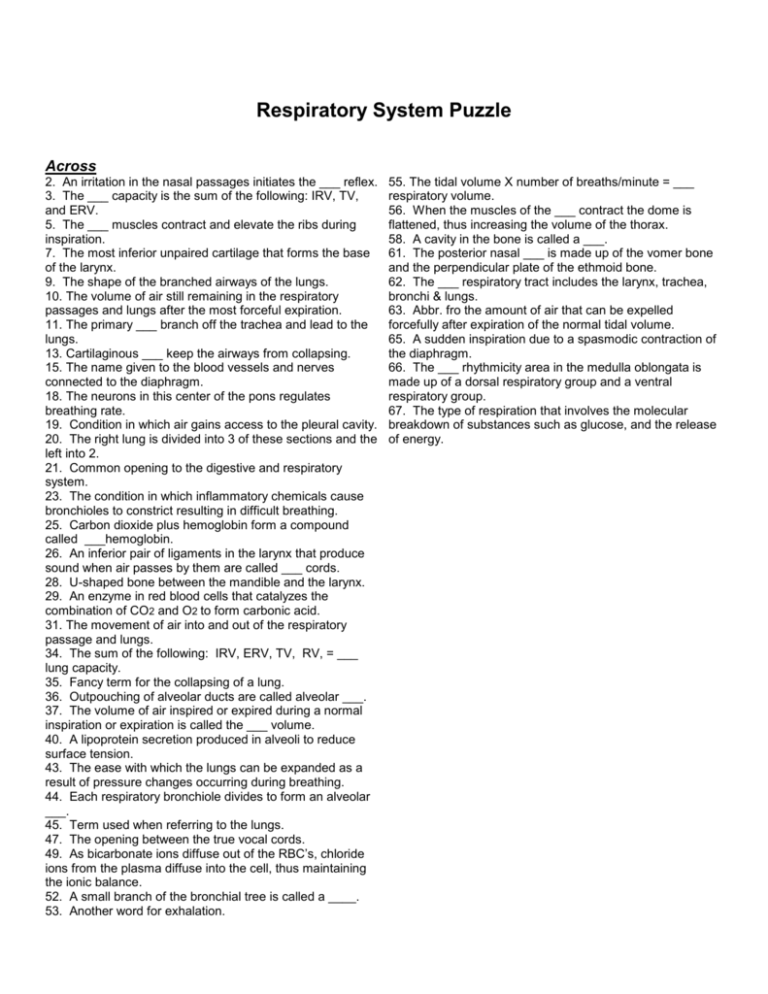
Respiratory System Puzzle Across 2. An irritation in the nasal passages initiates the ___ reflex. 3. The ___ capacity is the sum of the following: IRV, TV, and ERV. 5. The ___ muscles contract and elevate the ribs during inspiration. 7. The most inferior unpaired cartilage that forms the base of the larynx. 9. The shape of the branched airways of the lungs. 10. The volume of air still remaining in the respiratory passages and lungs after the most forceful expiration. 11. The primary ___ branch off the trachea and lead to the lungs. 13. Cartilaginous ___ keep the airways from collapsing. 15. The name given to the blood vessels and nerves connected to the diaphragm. 18. The neurons in this center of the pons regulates breathing rate. 19. Condition in which air gains access to the pleural cavity. 20. The right lung is divided into 3 of these sections and the left into 2. 21. Common opening to the digestive and respiratory system. 23. The condition in which inflammatory chemicals cause bronchioles to constrict resulting in difficult breathing. 25. Carbon dioxide plus hemoglobin form a compound called ___hemoglobin. 26. An inferior pair of ligaments in the larynx that produce sound when air passes by them are called ___ cords. 28. U-shaped bone between the mandible and the larynx. 29. An enzyme in red blood cells that catalyzes the combination of CO2 and O2 to form carbonic acid. 31. The movement of air into and out of the respiratory passage and lungs. 34. The sum of the following: IRV, ERV, TV, RV, = ___ lung capacity. 35. Fancy term for the collapsing of a lung. 36. Outpouching of alveolar ducts are called alveolar ___. 37. The volume of air inspired or expired during a normal inspiration or expiration is called the ___ volume. 40. A lipoprotein secretion produced in alveoli to reduce surface tension. 43. The ease with which the lungs can be expanded as a result of pressure changes occurring during breathing. 44. Each respiratory bronchiole divides to form an alveolar ___. 45. Term used when referring to the lungs. 47. The opening between the true vocal cords. 49. As bicarbonate ions diffuse out of the RBC’s, chloride ions from the plasma diffuse into the cell, thus maintaining the ionic balance. 52. A small branch of the bronchial tree is called a ____. 53. Another word for exhalation. 55. The tidal volume X number of breaths/minute = ___ respiratory volume. 56. When the muscles of the ___ contract the dome is flattened, thus increasing the volume of the thorax. 58. A cavity in the bone is called a ___. 61. The posterior nasal ___ is made up of the vomer bone and the perpendicular plate of the ethmoid bone. 62. The ___ respiratory tract includes the larynx, trachea, bronchi & lungs. 63. Abbr. fro the amount of air that can be expelled forcefully after expiration of the normal tidal volume. 65. A sudden inspiration due to a spasmodic contraction of the diaphragm. 66. The ___ rhythmicity area in the medulla oblongata is made up of a dorsal respiratory group and a ventral respiratory group. 67. The type of respiration that involves the molecular breakdown of substances such as glucose, and the release of energy. Respiratory System Puzzle DOWN 1. Respiratory organ that consists of an outer casing of nine cartilages that are connected by muscles and ligaments. 2. The primary bronchi branch into ___ bronchi which lead into the lungs. 4. These tubes branch from a bronchiole and are called ___ bronchioles. 5. During ___ the volume of pleural spaces increase causing intrapulmonary pressure to decrease and the air enters the lungs. 6. The instrument that is used to measure lung volumes and capacities. 8. The PO2 of capillary blood is 40mm of Hg, that of alveolar air is 104 mm of Hg. The direction of oxygen ___ is from alveolar air into the blood. 10. ____ bronchioles branch off the terminal bronchioles. 12. A loosely associated collection of lymph nodules in the pharynx. 14. The lobes of the lung is divided into nine of these on the left and ten on the right. 16. The ___ ____ is located inside the external nose and joins to the pharynx. 17. Foreign particles in the bronchi and trachea are expelled by a ___ reflex. 19. The potential space between the visceral and parietal pleurae. 22. Abbr. for the volume of air inspired and expired during normal breathing. 23. A microscopic structure in the lung where the exchange of O2 and CO2 takes place between the air in the lung and the blood. 24. A membranous tube leading to the lungs from the pharynx. 27. Respiratory ___ syndrome occurs in premature babies because surfactant is not produced in adequate amounts before 7 months of development. 28. A deficiency of oxygen to a tissue. 30. Expiration and inspiration occur because of ___ differences between the lungs and the atmosphere. 32. The respiratory ___ is divided into upper and lower regions. 33. Name given to the superior portion of the pharynx. (nostrils to uvula). 35. Neurons from the ___ center in the pons stimulate the inspiration center. 38. Abbr. for the type ciliated tissue that lines most of the respiratory tract. 39. During swallowing the ___ covers the opening of the larynx. 41. The soft process that extends from the posterior edge of the soft palate. 42. Three paired bony ridges that make up the lateral wall of the nasal cavity. 44. The part of the respiratory system in which gas exchange does not take place is called anatomical ___ ___ space. 46. Hyaline ____ makes up the C-rings of the trachea and bronchi. 48. The largest and the most superior of the cartilages that compose the larynx is the ___ cartilage. 50. The principal organs of the respiratory system with the largest volume. 51. A disease in which the lung surface and elasticity is lost due to a respiratory irritation such as tabacco smoke and polluted air. 53. The forces responsible for normal expiration come from ___ recoil of tissues and from surface tension. 54. The ___ ventilation rate = (tidal volume - physiological dead space) X breathes/minute. 57. This type of ventilation causes a lowering of the blood carbon dioxide and rise in pH. 59. The abbr.for the amount of air that can be inspired forcefully after inspiration of the normal tidal volume. 60. The ___ respiratory tract consists of the nasal cavity, pharynx and associated structures. 64. The abbr.for residual volume.


